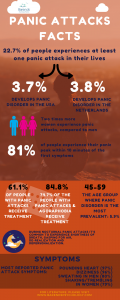Panic disorder diagnosis – the official criteria
More than one in every five people experiences a panic attack at least once in their lives; women are twice as likely to have a panic attack, compared to men [1],[2],[3]. Fortunately, not every person who experienced a panic attack will get a panic disorder diagnosis (between 3.7 and 4.1% of people has a panic disorder diagnosis once in their lives [1],[4],[5]).
A panic disorder diagnosis helps therapists and researchers to develop the most effective panic disorder treatment, to find out what its causes are, and to test if panic attacks can be prevented in the future. The same diagnosis helps a patient/client to understand what is happening to them, and to find proper treatment for their mental disorder. This page discusses the panic disorder diagnosis and explains what each official criterion means. NOTE: the official criteria for panic disorder are obtained from the DSM V (2013).
At Barends Psychology Practice, we treat Panic attacks Online and in person. Contact us to schedule a first, free of charge, session. (Depending on your health insurance, treatment may be reimbursed).
Quick Jump-to menu:
What is a panic attack?
Panic attack causes.
Panic disorder treatment.
How do stop panic attacks.
Panic disorder self-test.
Interesting panic attacks facts.
Online therapy for panic disorders.
Take me to the homepage.
Panic disorder diagnosis – the official criteria
The person experiences recurring, unexpected panic attacks. At least one of these attacks has been followed by a 1-month period in which the individual worries about having additional attacks or their implications (e.g., having a heart attack), and/or the individual has changed his or her behavior in a maladaptive way (e.g., avoiding situations that may provoke panic sensations). The person may go on to experience varying frequencies and intensities of expected and unexpected panic attacks.
Panic attacks are characterized by an abrupt surge of intense fear or physical discomfort, reaching a peak within a few minutes, in which at least 4 of the following symptoms are present:
- Palpitations, pounding heart, tachycardia
- Sweating
- Muscle trembling, shaking
- Shortness of breath, sensations of smothering
- Choking sensations
- Chest pain or discomfort
- Nausea, abdominal distress
- Dizzy, lightheaded, instability, feeling faint
- Derealization, depersonalization
- Fears of losing control or going crazy
- Fear of dying
- Numbness, tingling sensations
- Chills, hot flushes.
NOTE: Panic attacks with <4 of the above-named symptoms are considered to be limited-symptom attacks.
In order to meet diagnostic criteria for panic disorder, the symptoms must not be attributable to substance-related effects (e.g., withdrawal, medication side-effects), other medical conditions (e.g., hyperthyroidism, menopause), or other psychiatric disorders (e.g., specific phobias, obsessive compulsive disorder).
If you are interested in finding out whether or not you are suffering from panic attacks or panc disorder, take the online test here: panic disorder test.
Literature:
- [1] Kessler, R. C., Chiu, W. T., Jin, R., Ruscio, A. M., Shear. K., & Walters, E. E., 2006. The epidemiology of panic attacks, panic disorders, and agoraphobia in the National Comorbidity Survey Replication. Arch. Gen. Psychiaty, 63, 415-424.
- [2] Goodwin, R. D., Farvelli, C., Rosi, S., Cosci, F., Truglia, E., de Graaf, E., Wittchen, H. U., 2005. The epidemiology of panic disorder and agoraphobia in Europe. Eur. Neuropsychopharmacol., 15, 435-43.
- [3] Sheikh, J. I., Leskin, G. A., & Klein, D. F. (2002). Gender differences in panic disorder: findings from the National Comorbidity Survey. American Journal of Psychiatry, 159, 55-58.
- [4] Lee, H. B., Hening, W. A., Allen, R. P., Kalaydjian, A. E., Earley, C. J., Eaton, W. W., & Lyketsos, C. G. (2008). Restless legs syndrome is associated with DSM-IV major depressive disorder and panic disorder in the community. The Journal of neuropsychiatry and clinical neurosciences, 20, 101-105.
- [5] Grant, B. F., Hasin, D. S., Stinson, F. S., Dawson, D. A., Goldstein, R. B., Smith, S., … & Saha, T. D. (2006). The epidemiology of DSM-IV panic disorder and agoraphobia in the United States: results from the National Epidemiologic Survey on Alcohol and Related Conditions. The Journal of clinical psychiatry.

